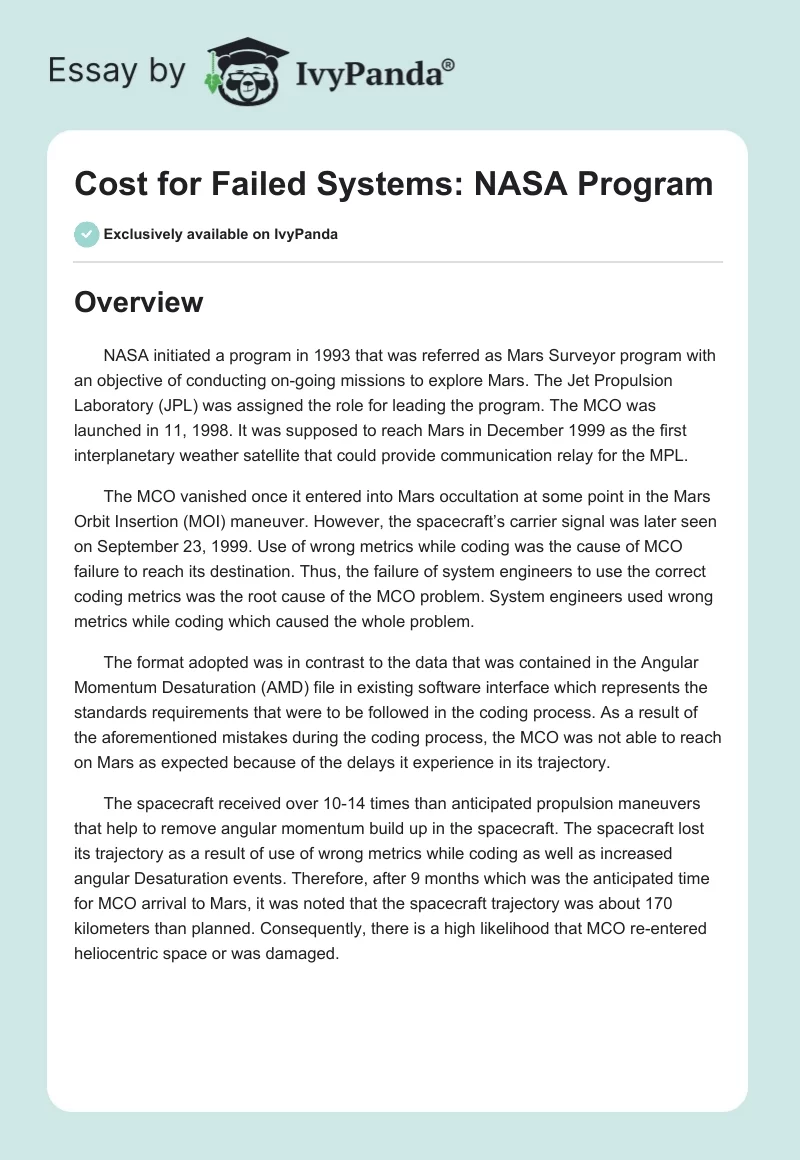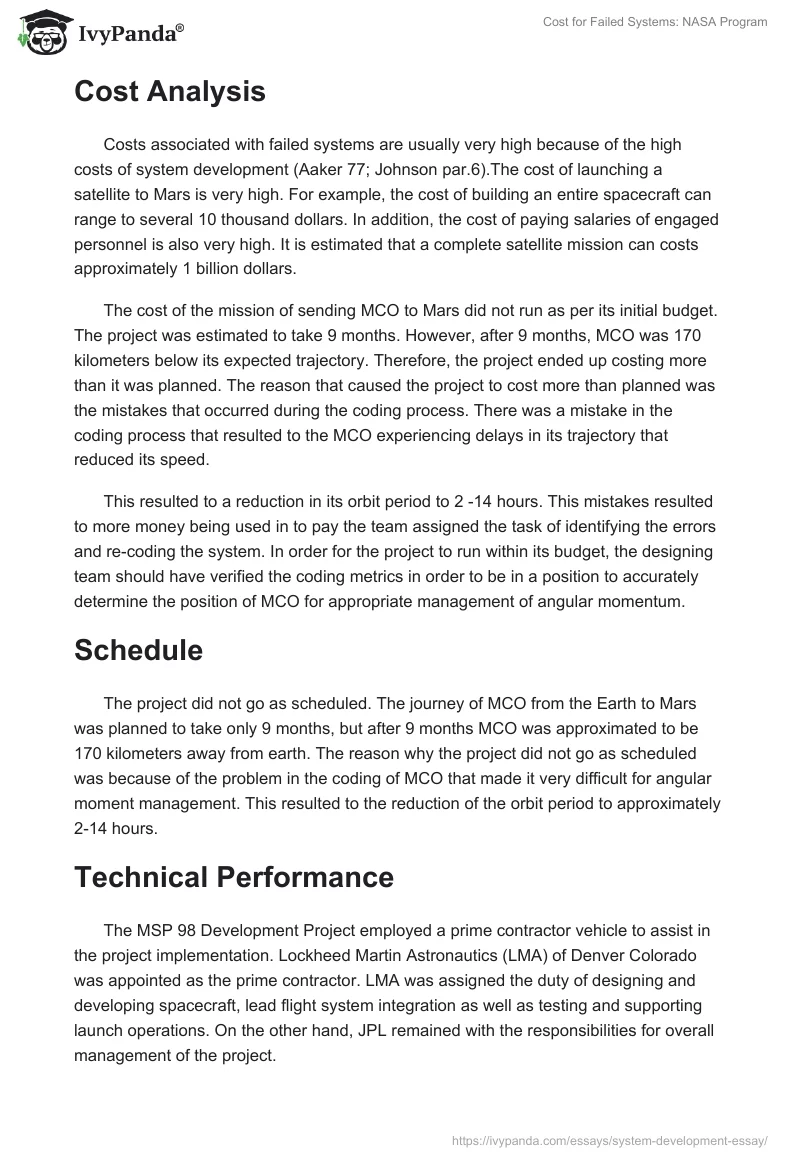Overview
NASA initiated a program in 1993 that was referred as Mars Surveyor program with an objective of conducting on-going missions to explore Mars. The Jet Propulsion Laboratory (JPL) was assigned the role for leading the program. The MCO was launched in 11, 1998. It was supposed to reach Mars in December 1999 as the first interplanetary weather satellite that could provide communication relay for the MPL.
The MCO vanished once it entered into Mars occultation at some point in the Mars Orbit Insertion (MOI) maneuver. However, the spacecraft’s carrier signal was later seen on September 23, 1999. Use of wrong metrics while coding was the cause of MCO failure to reach its destination. Thus, the failure of system engineers to use the correct coding metrics was the root cause of the MCO problem. System engineers used wrong metrics while coding which caused the whole problem.
The format adopted was in contrast to the data that was contained in the Angular Momentum Desaturation (AMD) file in existing software interface which represents the standards requirements that were to be followed in the coding process. As a result of the aforementioned mistakes during the coding process, the MCO was not able to reach on Mars as expected because of the delays it experience in its trajectory.
The spacecraft received over 10-14 times than anticipated propulsion maneuvers that help to remove angular momentum build up in the spacecraft. The spacecraft lost its trajectory as a result of use of wrong metrics while coding as well as increased angular Desaturation events. Therefore, after 9 months which was the anticipated time for MCO arrival to Mars, it was noted that the spacecraft trajectory was about 170 kilometers than planned. Consequently, there is a high likelihood that MCO re-entered heliocentric space or was damaged.
Cost Analysis
Costs associated with failed systems are usually very high because of the high costs of system development (Aaker 77; Johnson par.6).The cost of launching a satellite to Mars is very high. For example, the cost of building an entire spacecraft can range to several 10 thousand dollars. In addition, the cost of paying salaries of engaged personnel is also very high. It is estimated that a complete satellite mission can costs approximately 1 billion dollars.
The cost of the mission of sending MCO to Mars did not run as per its initial budget. The project was estimated to take 9 months. However, after 9 months, MCO was 170 kilometers below its expected trajectory. Therefore, the project ended up costing more than it was planned. The reason that caused the project to cost more than planned was the mistakes that occurred during the coding process. There was a mistake in the coding process that resulted to the MCO experiencing delays in its trajectory that reduced its speed.
This resulted to a reduction in its orbit period to 2 -14 hours. This mistakes resulted to more money being used in to pay the team assigned the task of identifying the errors and re-coding the system. In order for the project to run within its budget, the designing team should have verified the coding metrics in order to be in a position to accurately determine the position of MCO for appropriate management of angular momentum.
Schedule
The project did not go as scheduled. The journey of MCO from the Earth to Mars was planned to take only 9 months, but after 9 months MCO was approximated to be 170 kilometers away from earth. The reason why the project did not go as scheduled was because of the problem in the coding of MCO that made it very difficult for angular moment management. This resulted to the reduction of the orbit period to approximately 2-14 hours.
Technical Performance
The MSP 98 Development Project employed a prime contractor vehicle to assist in the project implementation. Lockheed Martin Astronautics (LMA) of Denver Colorado was appointed as the prime contractor. LMA was assigned the duty of designing and developing spacecraft, lead flight system integration as well as testing and supporting launch operations. On the other hand, JPL remained with the responsibilities for overall management of the project.
Mars Surveyor Operation Project (MSOP) was assigned the responsibility for managing flight operations for MPL, MGS and MCO. Despite, the great delegation of responsibilities to enhance performance, the project failed to satisfy its technical performance requirement. The software engineers failed to follow the design specifications while coding the ground software file.
The factor that contributed to this problem is the failure of the designing team to verify the metrics required for coding from the requirement documentation file that was available for the designers to confirm design specifications.
Risks
The system engineers failed to ensure that correct metrics were followed when coding the ground software file that resulted to the overall failure of the project. The MCO lost its trajectory that made it impossible to reach its intended destination as planned (Hernandez 12).
System Engineering
System engineers are required to make sure that there is teaming, effective coordination and communication in designing. They are responsible for designing, integration as well as to ensure systems operate as expected through formal testing. It is also their duty to ensure that there is transition in the production process. Moreover it is their duty to ensure that they create, maintain as well as document all requirements to enable efficient planning and execution (Laverty par.2; Petit par. 8).
System engineers in this project efficiently created as well as maintained programmatic and technical documentation as required. However, they failed to manage system configuration that resulted to the use of wrong metrics while coding. In order to avoid such a mistake, the system engineers could have ensured that they oversee all transitions during the development of the system.
Lesson Learned
This case study offered a very important learning opportunity for system engineers in identifying how mistakes happen in systems development as well as the grave consequences of such mistakes. Therefore, this case study was very informative to system engineers in cautioning them that system engineers should ensure that they follow specified guidelines to make sure that all procedures are followed to the letter.
By observing specified guidelines, they will ensure that specification during system development are met which will help in ensuring that systems are developed successfully and within reasonable time frame, to reduce expenses associated with delays or faulty systems. As learned from this case study, the project was not able to run as per its schedule. In addition, the project expenses exceeded its budget allocation because of the failure of system engineers to follow required specifications while coding.
Works Cited
Aaker, David. Cost for Failed systems. New York: Prentice Hall. 1998, print.
Hernandez, Pedro. Risks and Mitigation in Software Development. New York: Prentice Hall, 2001, print.
Johnson, Stephen. “Success, Failure and NASA Culture.” Ask.2008. Web. https://appel.nasa.gov/2008/09/01/success-failure-and-nasa-culture/
Laverty, Shea. “System Engineers Responsibilities.” eHow.2011. Web. https://careertrend.com/about-6389387-solution-architect-job-description.html
Petit, Charles. “Report for the Red Planet.” National Geographic. 2012. Web. https://www.nationalgeographic.com/science/space/universe/mars-rover-report/


